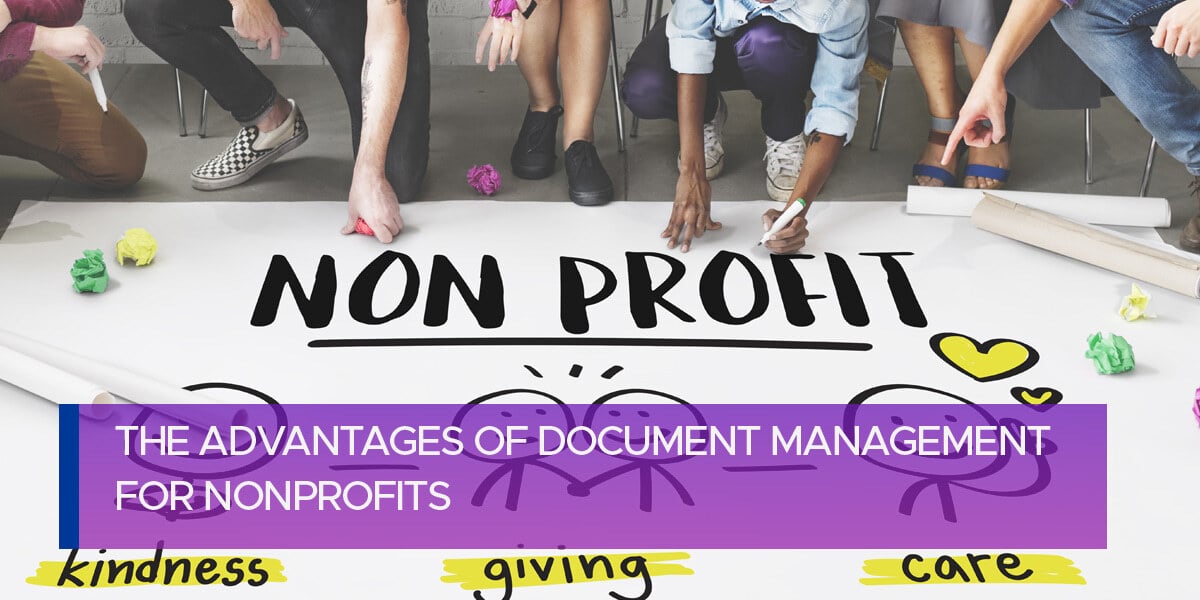
The Advantages of Document Management for Nonprofits
Running a nonprofit isn’t easy. The Urban Institute reports 1.56 million nonprofits are operating with a skeletal staff and razor-thin budgets. Making matters worse, viral sensations like the ALS Ice Bucket Challenge and crowdfunding sites like GoFundMe make every nonprofit a tech nonprofit. However, document management helps nonprofits operate in these heavy conditions.
It would seem like a viral charity or tech nonprofit marketplace would increase charitable giving. Giving USA estimates $427.71 billion was given to nonprofits in 2018. That number, however, declined from previous years. Advanced technology and connectivity reallocate charitable giving, rather than increase it.
Document management for nonprofits provides six key benefits to compete in this competitive economy.
1. More Time for Volunteers
Staffing is a big cost-saver for nonprofits. By relying on a mostly volunteer labor force, nonprofits save exponentially over for-profit companies. Even the skeletal crew that gets paid is compensated an average of $7.86 less than their for-profit peers.
Document management helps nonprofits automate repetitive tasks, so volunteers spend their time volunteering. Employee onboarding typically takes up to six months, but seasonal volunteer opportunities may not even last that long. Nonprofits need everyone starting and moving as fast as possible.
2. Using a Single Database
Document management for nonprofits streamlines all internal workflows so the organization can handle the logistics. Volunteers aren’t paid, but they have a higher turnover rate. This increases the organization’s recruiting, hiring, and training costs.
On top of this, nonprofits archive and maintain detailed records of volunteer vs. paid hours, donors, board members, and other tax information. It’s not unusual for even a tech nonprofit to lose data when things aren’t organized into a single database. These mistakes are costly to clean up, and proactively correcting them increases a nonprofit’s financial stability.
3. Reduce Paper Use and Costs
Paper documents are a significant expense for nonprofits. Printing, faxing, mailing, storing, even destroying paper documents has an associated cost. A small business of 15 employees can spend an average of $2,000 per year on paper-related expenses. This doesn’t include the costs of mistakes made from manual processes.
Document management for nonprofits digitizes the process at every endpoint to reduce the need for paper. When the paper is inevitably received, it can be easily digitized and stored in the same centralized database. This creates a secure environment that’s easier to navigate when needed.
4. More Efficient Workflow
The worst part about not having a budget is every team within the nonprofit organization uses different processes and platforms. Moving people and documents between individual processes can create chaos and bottlenecks if not adequately managed.
Document management for tech nonprofits creates a streamlined digital workflow. Every task can be tracked through each stage, and queues are created to optimize all internal processes. This creates more throughput for the staff to produce quality work.
5. Record Retention
With so many donors, volunteers, and workers coming and going, record keeping is vital. As selfless as it is, the tax benefits of donating time, money, and resources to charity are worth it. Nonprofits have a lot more paperwork to track than for-profit corporations to make this happen. The IRS Form 990 must be filled out precisely and accurately to be accepted.
Document management provides secure storage of vital records. It also ensures records are easily retrievable during tax time, audits, or other financial and operational matters. Failure to maintain accurate records is a costly mistake.
6. Disaster Recovery
The worst-case scenario for a nonprofit (or for-profit, for that matter) is a disaster. A massive data breach, utility shutdown, natural disaster, or another emergency can be devastating. For-profit businesses often have enterprise risk management (ERM) plans in place. It would behoove nonprofit organizations to follow in their footsteps.
At its core, an ERM plan outlines how to maintain critical operations in the event of any type of disaster. It outlines data, system, and staff redundancies to ensure there’s always a backup plan in place. When a disaster hits, document management helps tech nonprofits continue helping those in need.
Become Tech Nonprofits Today
The internet impacted the world in a variety of ways. People are more connected to valuable information than ever before. Keeping up in this fast-paced, always-on economy isn’t easy. It’s necessary, however, for every nonprofit to do.
Document management for nonprofits helps organizations running with skeletal crews, and minimal resources compete. These lean work models digitize workflows to reduce overhead spending and reduce the errors caused by a high-churn, low-paid (if at all) workforce.
Nonprofits can’t afford to waste resources. They’re known for making things happen on a shoestring budget. It’s not for the weak of heart, but VA Business Systems understands the unique hurdles tech nonprofits face.
Contact VA Business Systems today to find out how to implement document management in your nonprofit today. We can help nonprofits with any level of tech aptitude or resources get started.
